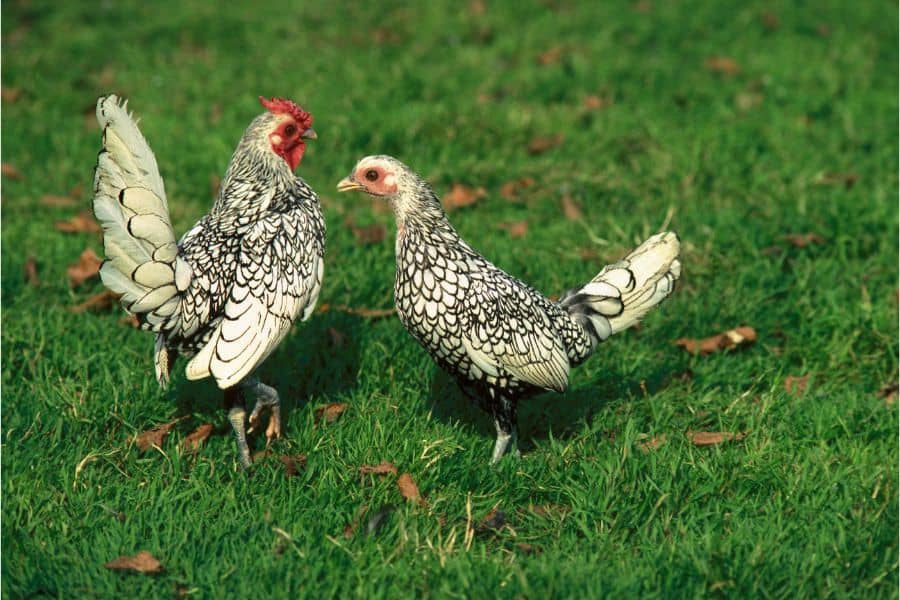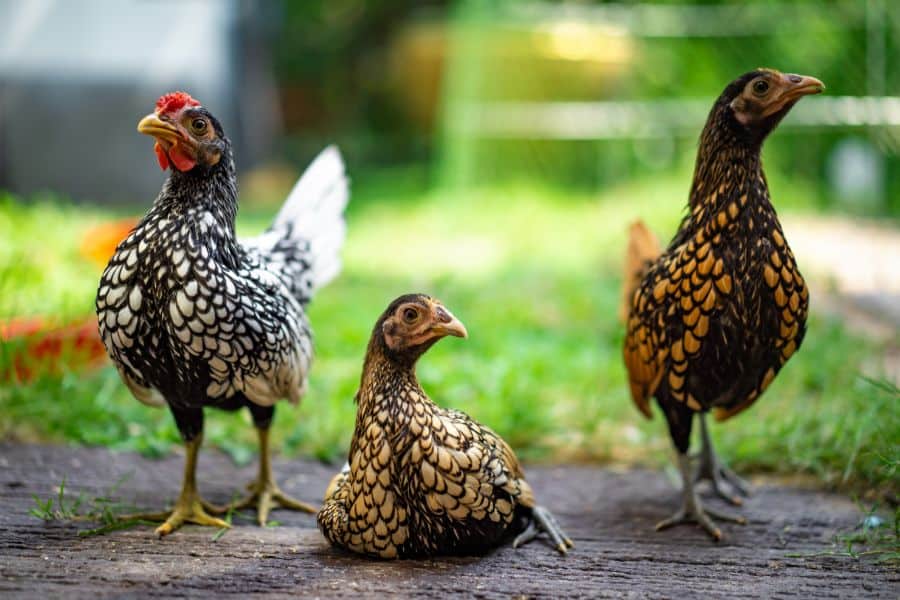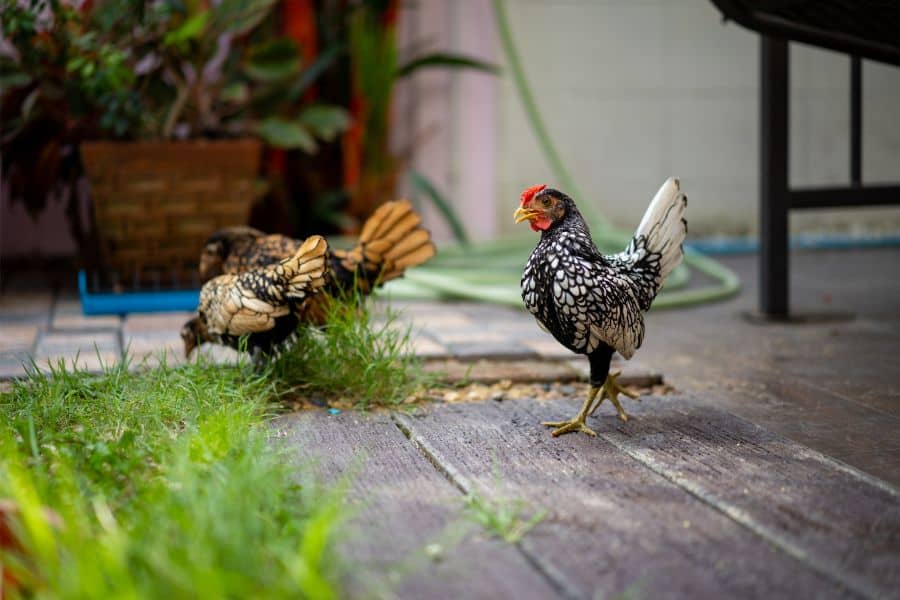Despite their diminutive stature, Sebright Chickens have a towering reputation, one that goes back all the way to the end of the 18th century. Despite not being the most utilitarian breed, these birds have remained popular throughout their existence.
The plumage, size, and posture of the Sebright chicken are all striking. The combination of these three is a bird that many enthusiasts have been eager to add to their flocks.
The influence of Sebright chickens extends beyond the world of poultry enthusiasts. The development of these birds helped to inspire one of the greatest minds of its generation.

Despite all their positives, rearing a Sebright chicken might be a task best left to experienced hands. Taking good care of these birds is a challenge due to multiple factors, and they are not easy to breed either.
Sebright chickens have a great personality, but you may not be up to the challenge of raising one. Read on to find out what you need to know about these beautiful British bantams.
Sebright Chicken Quick Facts:
| Names | Sebright |
| Origin | United Kingdom |
| Purpose | Pets and Exhibition |
| Egg Production/Year | Less than 100 |
| Climate | Not Cold Hardy |
| Plumage Color | Gold with black lacing, Silver with black lacing |
| Weight | Hens: 510g
Roosters: 620g |
| Personality | Friendly but not cuddly; loves to fly |
| Unique Fact | Was the first breed of poultry to have its own enthusiasts club. |
The Long History of Sebright Chickens
Origins
The story of Sebright Chickens started roughly 20 to 30 years before it was introduced to the world. The man who set out to develop them, Sir John Saunders Sebright, was looking to create a bantam chicken with plumage that had lacing similar to the laced Polish chicken’s.
To achieve this, he is said to have collected birds that were considered odd and gamey from the countryside. It is also thought he may have brought in chicken breeds from other countries as well.
The two challenges that stumped the gentleman farmer the most were:
- Attaining the type of lacing he was looking for.
- Getting the chickens to breed true.
By 1810, Sir John Saunders Sebright had succeeded, and he finally introduced the Sebright Chicken to the world.
Continuation of the Breed
It is not known which breeds were used in the development of the original Sebright Chicken. The Nankin, Hamburgh, Pit Game, and Polish chickens are some of the breeds thought to have been used in the process.
The gold Sebright chicken was the first plumage variety of this breed, but it wouldn’t be the last.
After acquiring a Rosecomb rooster from the Zoological Society of London’s Zoological Gardens, John Sebright crossed it with his gold Sebright chickens. This was how the silver Sebright Chicken was born.
Following the development of these two variants, a few more would show up in other parts of Europe, notably:
- The black-laced lemon Sebright Chicken
- The Buff Sebright (white-laced)
Legacy of Sebright Chickens
Charles Darwin who wrote On the Origin of Species is said to have been partly influenced by the breeding work done for the development of the Sebright Chicken.
He is known to have read at least one of the pamphlets written by Sir John Sebright on the breeding of domestic animals. Charles Darwin also cited the breeding of the Sebright chicken in some of his works.
The Sebright Bantam Club was the first association of its kind that was dedicated to a single breed of chickens. It was established around 1810 by Sir John Sebright himself.
The Sebright Chicken was included in both the first British Poultry Standard in 1865 and the first Standard of Perfection by the American Poultry Association in 1874. Back in 1865, the British Poultry Standard was known as the Standard of Excellence in Exhibition Poultry.
The Appearance of Sebright Chickens
Size
Sebright Chickens are not just bantam chickens, they are true bantams. True bantams have no equivalent that is of normal size.
The male Sebright chickens weigh about 620 grams. The females are even smaller, weighing around 570 grams.
Related: Small Chicken Breeds
Plumage
The original Sebright chicken has a base color that is dark gold. The lacing around the feathers’ edges is black.
On the silver Sebright chicken, the base color of the plumage is a whitish silver, but the color of the lacing is still black. The white lacing is only seen in the buff variant of the Sebright.
Other Features
The Sebright Chicken’s characteristic appearance doesn’t only come from its plumage.
They have short backs and large breasts that are pushed forward. Their wings are large considering the size of the birds and pointed downwards while their full tails are carried high at nearly 70 degrees.
The legs of the roosters are shorter and thicker than those of the females, but both are colored slate blue and don’t have feathers.
The same slate-blue color might be seen on the beaks of silver-laced Sebrights, but these can also be horn colored. The gold-laced Sebrights have beaks that are a darker horn color.
Sebright chickens have big, black, and circular eyes which make them look constantly curious.
Today, you’re more likely to see Sebright chickens with bright red combs, wattles, and earlobes. However, these were originally mulberry-colored and show standards still prefer birds that showcase the original mulberry color.
Take a look at the flock of Sebright chickens below.
Hen Feathering in Sebright Roosters
A peculiar feature of Sebright roosters’ appearance is a phenomenon known as hen feathering. This is a situation where the roosters have feathering that is like those of the hens.
In regular chicken breeds, the roosters have feathers that are longer and sharper in their necks, saddles, and tails compared to the hens. The males of the few breeds that exhibit hen feathering have feathering that lacks these features and is like that of the hens.
Sebright roosters that don’t have hen feathering are favored by some breeders who associate hen feathering with poor fertility in male Sebright chickens. However, these types of roosters are automatically disqualified from shows.
Hen feathering has made the Sebright chicken an important subject in molecular biology. It is used to study sex hormones because of how the skins of the roosters convert so much of the male sex hormone into estrogen.
Purpose of Sebright Chickens
Exhibition
Sebright chickens have had one true purpose from the time they were developed. John Saunders Sebright developed this chicken to be an ornamental breed and that is the main purpose it continues to serve today.
Ornamental bantam chickens are far from unusual, but Sebrights are in a different class.
They are ranked in the top ten in the list of most popular bantam chickens by the American Bantam Association. This is an impressive feat because Sebright chickens are challenging to breed.
Utility
The sizes of Sebright chickens and their eggs mean it is not a utilitarian breed by any stretch of the imagination. With the heaviest of the breed only weighing around 620 grams, these beautiful birds would make lousy meat birds.
Sebright chickens might have had some utility on the farm if they were good layers, but they only lay about 60 to 80 of their small eggs in a year.
Tips for Rearing Sebright Chickens
Housing and Environment
Sebright chickens are not recommended for beginners in poultry farming. Certain aspects of their rearing are challenging including how to create an environment in which they can thrive while being manageable.
Some of the tips you can follow when in this regard include:
- Sebrights are not cold hardy. If you intend to raise one in a cooler climate, you must take measures to protect them from the cold weather.
- Sebright chickens also don’t like dampness so ensure they won’t have to endure such conditions wherever they are housed.
- Sebright chickens are very good fliers and will take the chance to roost in a tree. Take appropriate measures to ensure the birds can’t fly out of your reach.
- These chickens like to forage so providing them with a covered run or some other enclosure is a good idea.
- This chicken breed can get quite loud especially when agitated. This can be a problem if you have close neighbors who are likely to be bothered by the noise.
Diet
A balanced diet just like you’d feed any other chicken will work for Sebright chickens too. You should provide them with good-quality chicken feed and supplement their feed with treats like vegetables, mealworms, and fruits.
The feed should be sufficiently small to enable the birds to ingest it without difficulty. This can be a problem with pellets intended for regular-sized chickens.
Temperament
Sebright chickens will grow up to be friendly if they are accustomed to being handled from a young age. They are, however, not as cuddly as some other breeds.
These chickens are curious and would much rather be active around the backyard than seated quietly on your lap. Some owners have also described the breed as being extremely chatty.
Lifespan
Sebright chickens are said to live for as long as 8 to 12 years because they are typically healthy once they mature. However, other sources claim a lifespan of 4 to 8 years, which is normal for bantam breeds, is more likely.
Health Issues
One of the reasons why Sebright chickens are not a good breed for beginners is the high mortality rate of chicks. The adults grow up to be hardy and not as susceptible to most diseases.
Marek’s disease is the kryptonite of Sebright chickens, and it is important to get your chickens vaccinated in time. Marek’s disease is a major problem in the poultry industry and unvaccinated chickens have very high mortality rates when infected by this disease.
The Challenge of Breeding Sebright Chickens
It is a testament to the dedication of breeders that Sebright chickens are not rarer than they are today. Breeding these chickens is quite challenging, and yet another reason why they are not recommended for beginners.
Some of the challenges in breeding Sebright chickens are:
- The hens are poor layers and manage less than 100 eggs in any given year.
- Some of the males are born infertile because of their genetics.
- The hens are not known for being broody and have negligible maternal instincts i.e., they don’t sit well and are unlikely to be good mothers to any hatchlings.
- Sebright chicks have a high mortality rate.
To successfully breed Sebright chickens you will have to contend with the limited number of eggs you’ll be working with. Additionally, you’ll either require a commercial incubator or a surrogate mother for the chicks.
You would also have to face the fact that many of the chicks hatched will not survive. Such challenges can make raising Sebright chickens a disheartening experience for beginners who may not even have mastered the basics of providing appropriate housing.
Some of the breeding challenges witnessed in Sebright chickens are said to be a consequence of inbreeding.
The birds you see today come from a small gene pool that has been inbred for more than two centuries. This has led to chickens that are delicate early in their lives and generally have poor fertility.
Also Read:
A Beautiful Bantam but not a Beginner Breed
Sebright chickens are beautiful and have a long and colorful history to match. The appeal of these birds is difficult to deny but it still may not be the chicken for you.
Sebright chickens are purely ornamental as their size and laying characteristics make them unsuitable for any other purpose. However, they are an extremely popular show bird and are among the most popular bantam breeds in the US.
The hen feathering seen in the male birds makes them an even more special breed, but some males are also born infertile. This contributes to a long list of problems that complicate the breeding of this chicken.
The flying ability of Sebright chickens may be impressive to witness but it can also stress you out if you don’t know how to address it effectively. If you have the experience and the patience, having these curious and friendly birds around can brighten up your home.


